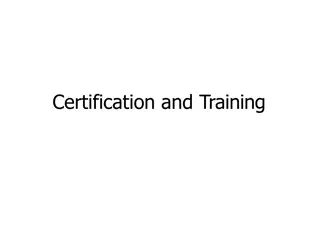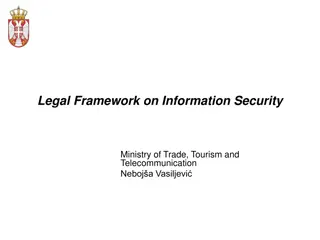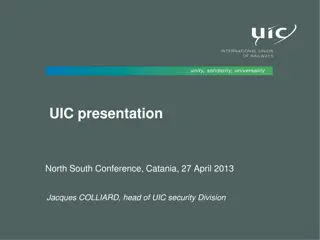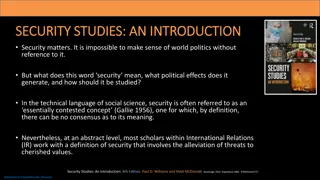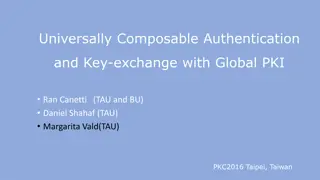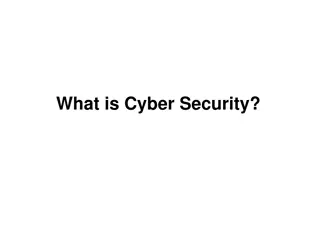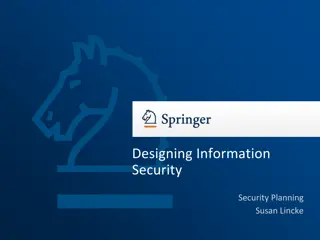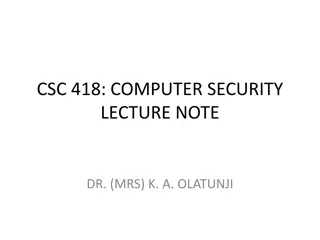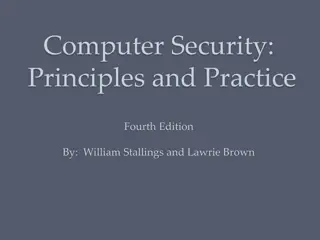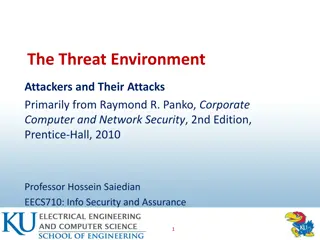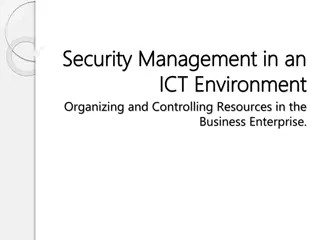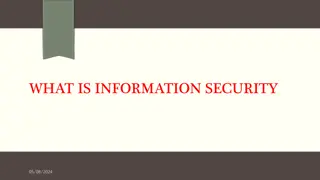Comprehensive Overview of Information Security Fundamentals
Gain knowledge on information security concepts, components, and applications with a detailed course outline covering topics like malicious code, cryptography, network security, and legal issues. Understand the importance of safeguarding information systems and the critical role of information security in today's data-driven world.
Download Presentation

Please find below an Image/Link to download the presentation.
The content on the website is provided AS IS for your information and personal use only. It may not be sold, licensed, or shared on other websites without obtaining consent from the author. Download presentation by click this link. If you encounter any issues during the download, it is possible that the publisher has removed the file from their server.
E N D
Presentation Transcript
Introduction to Information Security Introduction & Overview 1. Syllabus Overview 2. Basic terms 3. Quick overview on information security Contents from Prof. Kwangjo Kim and Other Sources
Course Detail Objectives: Upon completion of this course, participants will have gained knowledge of information security concepts, basic components and applications. Class hour: Friday: 5.30-8:30 PM 3 Hours per week Total Credit Hours: 45 Course Credit Total Credit : 3 Internal Assessment: 20 Marks + Seminar Works: 10 Marks Final : ?? Marks
Course Outline- Units 1. Introduction to Information Security- 2. Malicious code and application attacks - 3. Cryptography and Key Management - 4. Authentication and Access Control 5. Network Security- 6. Auditing and Monitoring 7. Legal, Ethical and Professional issues in InfoSec 8. Disaster Recovery and Business Continuity 4 Hrs 8 Hrs 8 Hrs 5 Hrs 5 Hrs 4 Hrs 6 Hrs 5 hrs
Terminologies Lots of new terminologies in every new fields 4
What is Information Security? Data recording of something measured Raw material, just measured Information Information is the result of processing, manipulating and organizing data in a way that adds to the knowledge of the receiver. Processed data Knowledge Knowledge is normally processed by means of structuring, grouping, filtering, organizing or pattern recognition. Highly structured information 5
What is Information Security? Information Systems An integrated set of components for collecting, storing, processing, and communicating information. Business firms, other organizations, and individuals in contemporary society rely on information systems to manage their operations, compete in the marketplace, supply services, and augment personal lives. Information Revolution A phrase we use to refer to the dramatic changes taking place during the last half of the 20th century in which service jobs based on information are more common than jobs in manufacturing or agriculture. Information becomes more and more important than materials, resources. Competitiveness comes from information How much information do you have? 6
What is Information Security? Information Security ( Information security is the process of protecting information from unauthorized access, use, disclosure, destruction, modification, or disruption The protection of computer systems and information from harm, theft, and unauthorized use. Protecting the confidentiality, integrity and availability of information Information security is an essential infrastructure technology to achieve successful information-based society Highly information-based company without information security will lose competitiveness , ) What kind of protection? Protecting important document / computer Protecting communication networks Protecting Internet Protection in ubiquitous world 7
Common Terms (1) Cryptography( aspects of information security Cryptanalysis( attempting to defeat cryptographic techniques Cryptology( ): The study of cryptography and cryptanalysis Cryptosystem( ): A general term referring to a set of cryptographic primitives used to provide information security Symmetric key primitives; Public key primitives Steganography: The method of concealing the existence of message ): The study of mathematical techniques related to ): The study of mathematical techniques for Cryptography is not the only means of providing information security, but rather one set of such techniques (physical / human security) 8
Common Terms (2) Cipher: Block cipher, Stream cipher, Public key cipher Plaintext/Cleartext ( ), Ciphertext ( Encryption/Encipherment( ) Decryption/Decipherment( ) Key (or Cryptographic key) Secret key Private key / Public key Hashing ( ( ) ) Authentication ( ) Message authentication User authentication Digital signature ( ) ) 9
Cryptology = Cryptography + Cryptanalysis Cryptography : designing secure cryptosystems Cryptography (from the Greek krypt s and gr phein, to write ) was originally the study of the principles and techniques by which information could be concealed in ciphers and later revealed by legitimate users employing the secret key. Cryptanalysis : analyzing the security of cryptosystems Cryptanalysis (from the Greek krypt s and anal ein, to loosen or to untie ) is the science (and art) of recovering or forging cryptographically secured information without knowledge of the key. Cryptology : science dealing with information security Science concerned with data communication and storage in secure and usually secret form. It encompasses both cryptography and cryptanalysis. 10
Cryptology Cryptography is a basic tool to implement information security Security goals Secrecy (confidentiality) Authentication Integrity Non-repudiation Verifiability More application-specific security goals Achieve these security goals using cryptography 11
Secret Key vs. Public Key Systems Symmetric Key Cryptosystem Encryption Decryption Plain Text Cipher Text Plain Text Key Key Shared key Public Key Cryptosystem Encryption Decryption Plain Text Cipher Text Plain Text Receiver s key Public Key Private Key 12
Attacks Attacks An efficient algorithm that, for a given cryptographic design, enables some protected elements of the design to be computed substantially quicker than specified by the designer. Finding overlooked and realistic threats for which the design fails Attacks on encryption algorithms Exhaustive search (brute force attack) Ciphertext-only attack Known-plaintext attack Chosen-plaintext attack Chosen-ciphertext attack 13
Security Threats Interruption/Denial of service Interception: eavesdropping, wiretapping, theft Modification Fabrication/Forgery Unauthorized access Denial of facts 14
Security Services Security services A service that enhances information security using one or more security mechanisms Confidentiality/Secrecy ( Authentication ( Integrity ( ) Non-repudiation ( ) Forgery Modification ) Interception ) Denial of facts Access control ( Availability ( ) ) Unauthorized access Interruption 15
CIA Traid Confidentiality - Is the concept of protecting the secrecy and privacy of information. Integrity - Is the concept of protecti ng the accuracy of information pro cessing and data from improper modi fication. Availability - Is the concept of ensur ing that the systems and data can be accessed when required.
Security Needs for Network Communications Availability Confidentiality Authentication Denial of Service Interception Forgery Wish to access!! Is Private? Who am I dealing with? Access Control Non-Repudiation Integrity Not SENT ! Unauthorized access Claim Modification Have you privilege? Who sent/received it? Has been altered? 17
Security Mechanisms Security mechanism A mechanism designed to detect, prevent, or recover from a security attack Encryption Authentication Digital signature Key exchange Access control Monitoring & Responding 18





